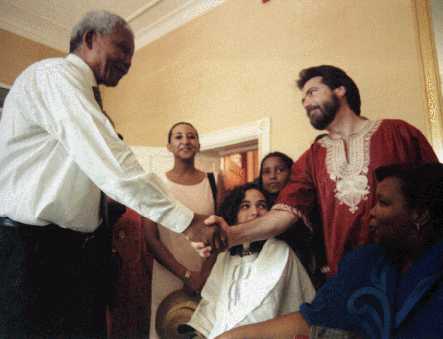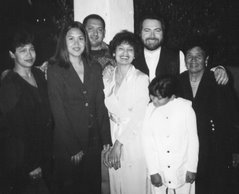
The amaXhosa’s first linkages with Asians and Europeans
(This piece was written by Hazel Crampton – author of ‘The Sunburnt Queen’ as a contribution to my exhibition ‘The ties that bind us’. Her book is available at exclusive books)
There are whole clans of people living along the Wild Coast of South Africa and scattered about the Eastern Cape, who are the descendants of survivors of shipwrecks. One of these clans is the amaMolo whose ancestors were Indian (slave) castaways. Another - and perhaps better known - clan is the abeLungu. Abelungu means “the whites”. Yet the abeLungu are black.
The story of these black whites is intimately bound up with the nature of the Wild Coast – and the very name of the place suggests why. South Africa is surrounded by sea on three sides. Its sea-routes are a shipping super-highway, and have been for hundreds of years. This highway has some of the most extreme weather in the world, especially along our eastern seaboard. The stretch we call the Wild Coast is particularly prone to terrifying storms. In addition, it is dotted with hidden reefs, practically devoid of natural harbours and subject to strange and capricious currents.
As if that’s not enough, the Wild Coast is one of only a few places in the world which has true freak waves. These gigantic freaks of nature as high as a five or six storey building, are capable of breaking the back of a large ship and sending it to the bottom in a matter of minutes. The upshot of all this is that the Wild Coast has become a veritable ships’ graveyard, notorious for its wrecks. Less well-known perhaps are the stories of their survivors.
The Sunburnt Queen is the story of one of these castaways. It is a true story, and it’s about a little girl called Bessie who was shipwrecked on the Wild Coast about 250 years ago.
Bessie was just one of thousands and thousands of people of all nationalities who were castaway on the shores of the Eastern Cape over the centuries. Most of their stories have been lost forever, but, by a double fluke of history, Bessie’s has not. Because she married into the Mpondo royal family she is remembered in the oral histories of her people, and because two of her children were still living when the first English missionaries first visited the area, her story was recorded in written history.
Bessie’s ship was wrecked at a place called Lambasi Bay, which is better known nowadays as Port Grosvenor, after the famous English East Indiaman and its legendary treasure which sank there in 1782, about half a century later. The Wild Coast appears to have hotspots that attract more than their fair share of wrecks and Lambasi Bay is one of them. Its most recent victim was the BBC China which went aground a year or so ago. Bessie was adopted by the amaMpondo. She grew up to be a woman of great beauty and wisdom, and married Sango an Mpondo prince and chief of the amaTshomane. They lived at Mngazana, just south of Port St Johns, and it is
there that Bessie lies buried. [Mngazana is just one river down from the popular holiday resort of Mngazi mouth.]
Bessie and her husband had several children, at least 5 of whom lived to adulthood. Their female descendants were much sought after as the wives of chiefs and even kings and as a result the descendants of the little English castaway were involved in the most pivotal events of the 19th century in the eastern Cape, events which in many ways helped to shape modern South Africa.
The Sunburnt Queen follows Bessie’s story, and those of her children and children’s children – and an assortment of other strange and wonderful runaways, robbers, rascals and (very occasionally) role-models who made this country what it is today. Our history is remarkably rich and the stories of castaways like Bessie is just one small part of a heritage waiting to be recovered and enjoyed.
(This piece was written by Hazel Crampton – author of ‘The Sunburnt Queen’ as a contribution to my exhibition ‘The ties that bind us’. Her book is available at exclusive books)
There are whole clans of people living along the Wild Coast of South Africa and scattered about the Eastern Cape, who are the descendants of survivors of shipwrecks. One of these clans is the amaMolo whose ancestors were Indian (slave) castaways. Another - and perhaps better known - clan is the abeLungu. Abelungu means “the whites”. Yet the abeLungu are black.
The story of these black whites is intimately bound up with the nature of the Wild Coast – and the very name of the place suggests why. South Africa is surrounded by sea on three sides. Its sea-routes are a shipping super-highway, and have been for hundreds of years. This highway has some of the most extreme weather in the world, especially along our eastern seaboard. The stretch we call the Wild Coast is particularly prone to terrifying storms. In addition, it is dotted with hidden reefs, practically devoid of natural harbours and subject to strange and capricious currents.
As if that’s not enough, the Wild Coast is one of only a few places in the world which has true freak waves. These gigantic freaks of nature as high as a five or six storey building, are capable of breaking the back of a large ship and sending it to the bottom in a matter of minutes. The upshot of all this is that the Wild Coast has become a veritable ships’ graveyard, notorious for its wrecks. Less well-known perhaps are the stories of their survivors.
The Sunburnt Queen is the story of one of these castaways. It is a true story, and it’s about a little girl called Bessie who was shipwrecked on the Wild Coast about 250 years ago.
Bessie was just one of thousands and thousands of people of all nationalities who were castaway on the shores of the Eastern Cape over the centuries. Most of their stories have been lost forever, but, by a double fluke of history, Bessie’s has not. Because she married into the Mpondo royal family she is remembered in the oral histories of her people, and because two of her children were still living when the first English missionaries first visited the area, her story was recorded in written history.
Bessie’s ship was wrecked at a place called Lambasi Bay, which is better known nowadays as Port Grosvenor, after the famous English East Indiaman and its legendary treasure which sank there in 1782, about half a century later. The Wild Coast appears to have hotspots that attract more than their fair share of wrecks and Lambasi Bay is one of them. Its most recent victim was the BBC China which went aground a year or so ago. Bessie was adopted by the amaMpondo. She grew up to be a woman of great beauty and wisdom, and married Sango an Mpondo prince and chief of the amaTshomane. They lived at Mngazana, just south of Port St Johns, and it is
there that Bessie lies buried. [Mngazana is just one river down from the popular holiday resort of Mngazi mouth.]
Bessie and her husband had several children, at least 5 of whom lived to adulthood. Their female descendants were much sought after as the wives of chiefs and even kings and as a result the descendants of the little English castaway were involved in the most pivotal events of the 19th century in the eastern Cape, events which in many ways helped to shape modern South Africa.
The Sunburnt Queen follows Bessie’s story, and those of her children and children’s children – and an assortment of other strange and wonderful runaways, robbers, rascals and (very occasionally) role-models who made this country what it is today. Our history is remarkably rich and the stories of castaways like Bessie is just one small part of a heritage waiting to be recovered and enjoyed.


No comments:
Post a Comment